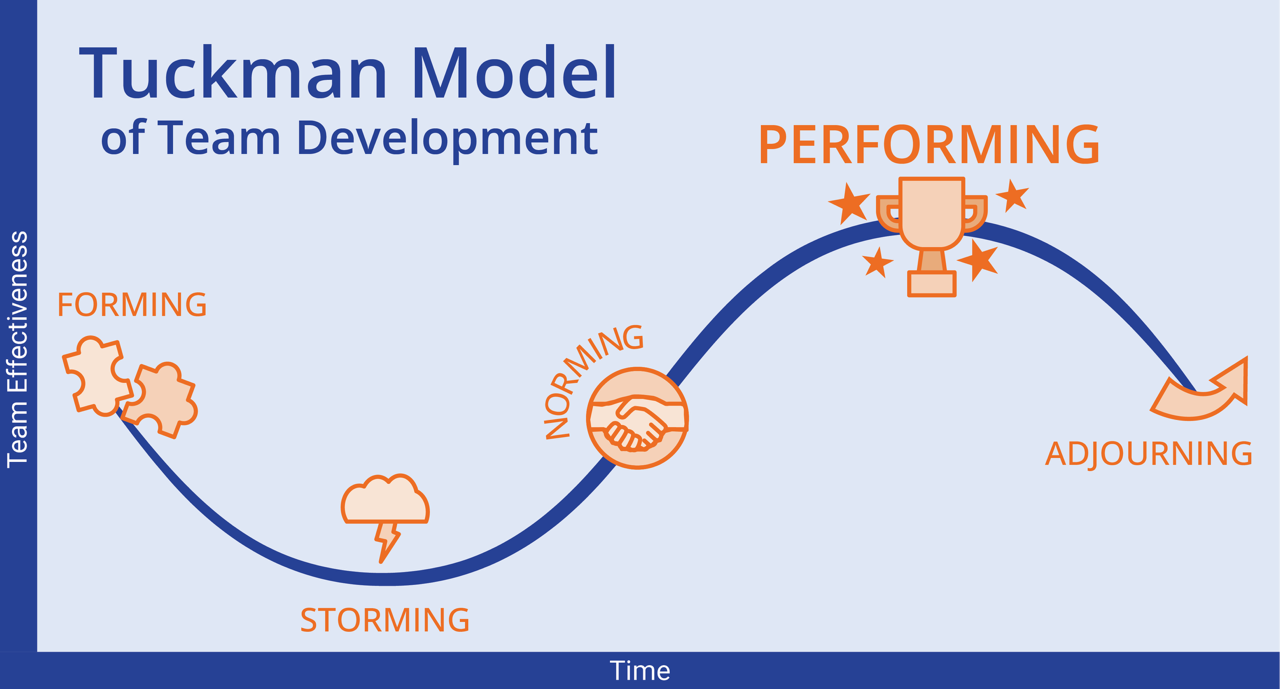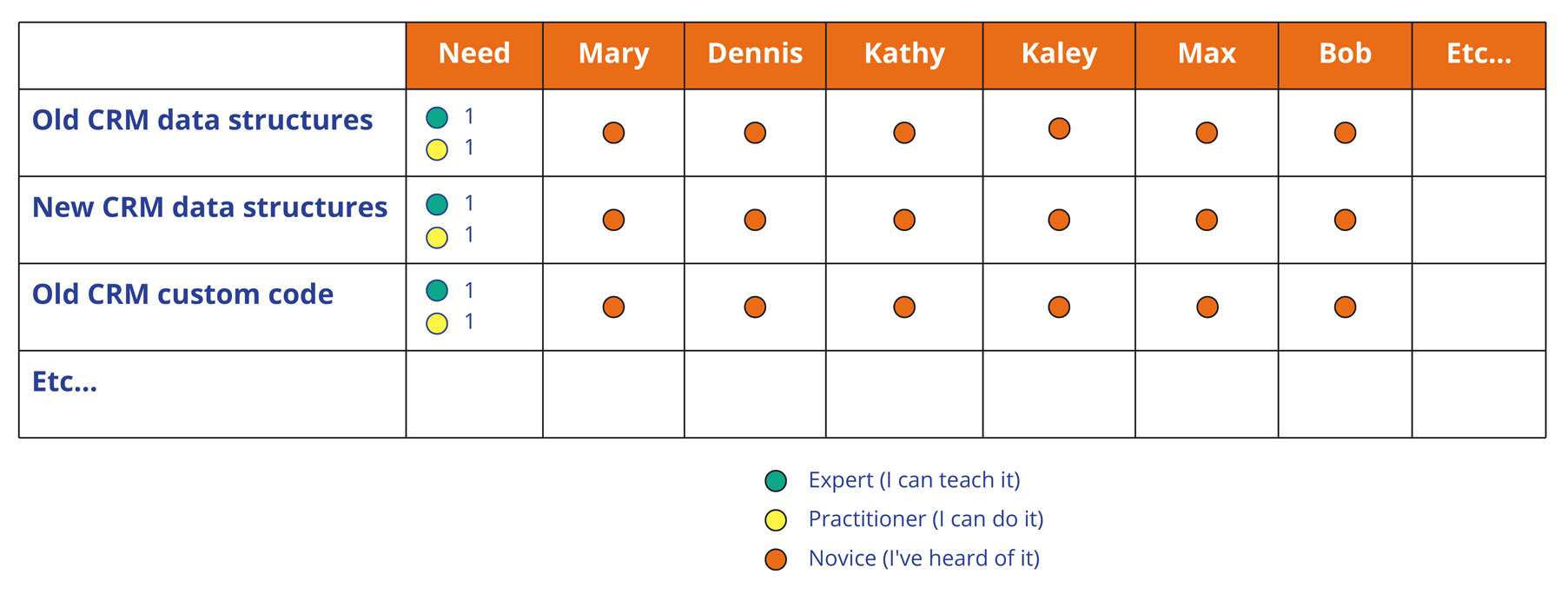Here at B2T we’re blessed to have a stable, high-performing team. In fact, Ali and I have been working together for 20 years now, and most of our other team members have been with us for many years as well. On the Tuckman model of team development, we’d definitely be here:

We all know that new teams take time to come together. But you can find yourself back at the “forming” step of the Tuckman model for a lot of different reasons:
- As mentioned, a new team is formed
- An existing team is given different work
- New team member(s) are introduced to an existing team
Our CRM conversion project threw us back into the “forming” stage because we needed to add new team members. I wanted to get us back to the “performing” stage as quickly as possible. Here are some keys to forming – or “re-forming” – a team that helped us get back to performing.
Have a Clear Vision and Purpose
In February, our blogs focused on the importance of scoping. If you missed those, we shared A 4-Step Approach to Managing Scope Creep and The Seven Deadly Sins of Scope Skippers. Keep in mind that scope isn’t just something to document at the beginning of a project and then forget about. It plays a valuable role throughout your project’s lifecycle. Specific to our current conversation, teams need to have a shared vision of success. If we don’t all understand the mission, then we’re not going to work together effectively.
NEW TEAM STARTUP TIP
Work together as a team to establish or clarify your project’s purpose, goals, and success measures.
TEAM RE-START TIP
Make sure new team members are provided with a clear understanding of the mission.
Assemble the Right Team
Our existing team had a competency gap. Part of the team competency matrix for our conversion project looked like this:

(Use our Team Competency Matrix template as the basis for your own team analysis.)
Our first instinct was to say, “Let’s hire a consultant who has experience converting CRM X to CRM Y.” But that’s as vague as saying, “We need an analyst” or “We need a developer”—too broad to be useful. Instead, we needed targeted expertise in:
- Identifying all the custom code that had been added to our existing CRM system
- Developing a data model for the custom data objects in the existing CRM system
- Performing gap analysis between our as-is state in the existing CRM and the out-of-the box functionality of the new CRM system.
- Establishing the best approach for implementing items that would require customization of the new CRM system.
Clearly defining the necessary skills helps ensure you have the right team in place. If gaps exist, you can create a plan to address them. In our case, we were able to bring in additional team members. When that’s not an option and you have to work with the people you’re given it’s a lot easier to go ask for help with resources if you have a specific set of needs defined.
TEAM STARTUP TIP
Be open to defining a role for a shared resource in the case of highly specialized needs.
TEAM RE-START TIP
Instead of adding a new team member, consider whether your skill gap might be a growth opportunity for an existing team member.
Define Roles and Set Clear Expectations
In her blog Don’t Drop the Ball! Defining a Wildly Productive Collaboration Model our former colleague Kate McGoey addresses role expectations and collaboration challenges. You may recall this illustration:

Having poorly defined or understood roles is a sure way to get a team stuck in the “storming” phase of the Tuckman. When your team is forming or “re-forming”, it’s important to make sure everyone understands who does what.
TEAM STARTUP TIP
Our Team Collaboration Model template can help your team explore roles and expectations.
TEAM RE-START TIP
Remember that new team members don’t automatically know who does what and where to go for help. Without proper guidance, they may waste time struggling on their own.
Maintain Accountability
My kids always dreaded group projects in school. There always seemed to be that one person on the team who didn’t do their work. The rest of the team either had to take on their share too or risk getting a bad grade. As long as they could pick their teammates, my kids didn’t mind group projects. But random groups? Ugh.
Your team should develop a way to measure progress against goals. Progress should then be regularly monitored and recognized. Address missed goals and expectations as soon as they are identified. The longer an issue drags on, the more negativity and resentment will build up in the team. Once that happens you not only have to deal with the backlog of work, you have to deal with the backlog of bad feelings.
TIP FOR ANY TEAM
When there is a perception that someone isn’t performing as expected, remember to do a little analysis. Just like we don’t want to jump to solutions on our projects, we don’t want to jump to conclusions when we perceive a problem with our team. Understanding the root cause of a performance problem before taking any sort of action is really important!
Cultivate Trust and a Sense of Belonging
How do you build trust on a team? Sadly, there’s no specific set of actions that will cause one person to trust another person. You can’t force someone to trust you. However, the best way to start down the path to trust is to behave in a trustworthy fashion. Some tips for demonstrating trustworthiness:
- Keep your promises. If you can’t, be transparent about it.
- Make good use of people’s time.
- Acknowledge negative past experiences but remain positive about the future.
- Recognize and appreciate others’ contributions.
- Refrain from speaking negatively about others.
- Short of a threat to someone’s health and safety, or the company’s brand, never divulge something shared in confidence.
Over time, high-performing teams develop personal connections in addition to professional ones. It’s harder to do– but especially important — when teams aren’t co-located. I encourage you to find ways to consciously make time and space for informal interactions between team members. As an example, our team holds a monthly “virtual coffee”. We don’t discuss business (in general) but use the time to catch up on everybody’s lives and important happenings.
TEAM STARTUP TIP
Choose a way to celebrate and recognize accomplishments that is unique and meaningful for your team.
TEAM RE-START TIP
Make sure to fill your new team members in on inside jokes and other team quirks so they feel like part of the “fam”.
Back to Performing!
The six steps above can go a long way toward moving your team through the “forming”, “storming”, and “norming” phases. Hopefully you’ve had an opportunity to be part of a truly high-performing team. It’s an incredibly rewarding experience. Instead of dreading work, I look forward to interacting with the rest of the team.
If you find yourself back at the start of Tuckman’s scale, we’ve recently launched two new workshops aimed at helping projects and teams get off to a healthy start. Our Team Startup Workshop will help you form – or “re-form” – your team while our Project Inception Workshop helps ensure the effective launch of a new project or initiative.
All the best,
–K.
Get the rest of the story!
This article is part of a series that we wrote based on challenges we faced during our own CRM conversion project in 2024. Each month we highlight a particular challenge and share tips, techniques, and tools you can use if you find yourself in a similar situation.

Kathy Claycomb
Managing Partner, Lead Expert
Kathy Claycomb brings over 35 years of experience to the classroom. She has participated in all phases of solution development using everything from agile to waterfall methodologies (and quite a few in between). Before joining B2T, her career spanned roles from application developer to Senior Director of Services at various organizations. Kathy has broad industry background including transportation, manufacturing, insurance, energy, healthcare, and banking.
Kathy’s first love is teaching, and throughout her career she has always managed to spend a portion of her time instructing. She has an engaging, highly interactive teaching style that ensures students leave the course with a thorough grasp of the material. Her students consistently praise her teaching abilities and her talent for drawing on her personal experience to enhance their learning.
Kathy served as the Technical Editor for Business Analysis for Dummies, 2nd Edition.

